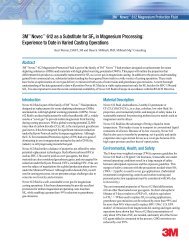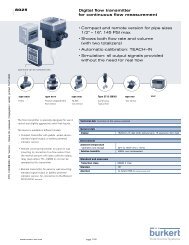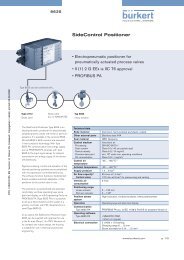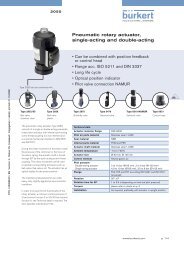Solenoid valves - Bürkert Fluid Control Systems
Solenoid valves - Bürkert Fluid Control Systems
Solenoid valves - Bürkert Fluid Control Systems
Create successful ePaper yourself
Turn your PDF publications into a flip-book with our unique Google optimized e-Paper software.
3.2.2. k v value<br />
The k v value, which is defined as follows,<br />
has been introduced to describe<br />
the flow behavior of <strong>valves</strong>:<br />
■ The k v value is the volume flow<br />
·<br />
V (in m 3 /h) of water ( 0 =1kg/dm 3 )<br />
at a temperature between 5 and 40<br />
°C at a pressure drop (permanent<br />
pressure loss) at the valve of<br />
0 =100 kPa.<br />
Since the k v value designates a volume<br />
flow (m 3 /h), the frequently encountered<br />
designations “flow-rate coefficient” or<br />
“valve coefficient” are misleading since<br />
they presuppose that k v is non-dimensional.<br />
3.2.3. c v value and Q Nn value<br />
In countries using the Imperial system,<br />
the cv value is used as the flow parameter<br />
instead of the k v value.<br />
From this equation, we can then deduce<br />
the following for the k v value:<br />
k v = · A<br />
2 · p 0<br />
0<br />
Equation 3<br />
For a valve, the k v value can be determined<br />
experimentally on the basis of<br />
the assumptions contained in the definition<br />
( 0 und 0 ). It thus represents<br />
a parameter for characterizing a valve.<br />
Thus, the k v value can initially be used<br />
as a measure of the quality of the flowdynamics<br />
design of <strong>valves</strong>. If, for example,<br />
we compare several <strong>valves</strong><br />
with the same nominal diameter, the<br />
valve with the highest k v value is the<br />
best-designed valve from a flow dynamics<br />
perspective.<br />
■ The c v value is the volume flow (in<br />
US gallons/minute) of water at a<br />
temperature of 60 °F with a pressure<br />
loss of 1 psi through the valve.<br />
Where:<br />
1USgallon/minute = 0.227 m 3 /h and<br />
1 psi = 0.069 bar (psi: pounds per<br />
square inch).<br />
The QNn value, which is defined as<br />
follows, is another flow parameter used<br />
for <strong>valves</strong> in pneumatics. The Q Nn value<br />
is the volume flow (in liters/minute) of<br />
air at a temperature of +20 °C and at<br />
an input pressure of 6 bar and a pressure<br />
drop through the valve of 1 bar.<br />
The following conversion factors apply<br />
for converting k v to c v and Q Nn :<br />
k v = 0.86 c v<br />
k v = 1078 Q Nn .<br />
28/29








